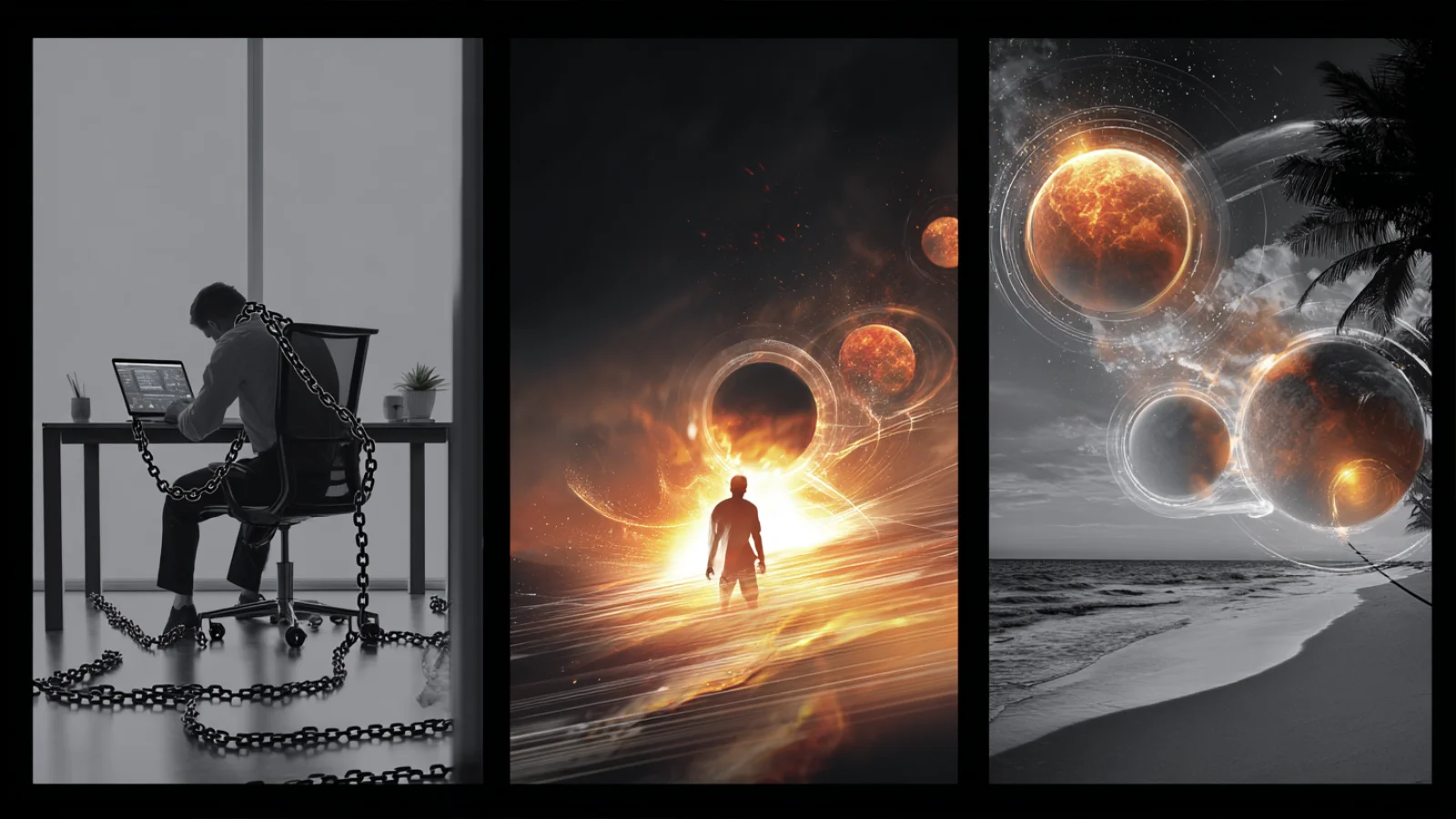
Own Shit That Pays You: The Only Investment Advice You Need
The last generation's wealth advice died quietly on a Tuesday. While your dad's retirement fund crawled up 6%, a Chrome extension was printing $70,000 a month[1].
Dan Ni, a former stock trader, ditched Wall Street to build a newsletter from his apartment. Started with $500. No investors. No team. Just him explaining tech news like a human being. Annual revenue now: $5 million[2].
This is the asset revolution. And you're probably missing it.
The Beautiful Lie We've All Been Sold
Here's what they taught you: Get a degree. Get a job. Max out your 401k. Buy a house. Wait 40 years. Die rich.
Here's what's actually happening: A 28-year-old sells a newsletter for $75 million[3]. A woman who couldn't code builds print-on-demand t-shirts that generate $120,000 yearly[4]. A Lithuanian developer creates a chat tool on weekends that pays him $90,000 annually—four years after he stopped touching it[5].
The old model wasn't just slow—it was a trap. You were building someone else's assets. Your time, your ideas, your energy—all of it flowed upward, enriching shareholders while you collected a paycheck and called it security.
But something shifted. The tools of production—once locked in corporate towers—scattered across the internet like seeds in a hurricane. Suddenly, anyone could own the means of their own prosperity.
The Three Levels of Ownership
Most people exist at Level Zero: The Renter's Trap. They rent their time to employers, rent their creativity to platforms, rent their future to the false promise of traditional investing. They own nothing that works while they sleep.
Level One is where awakening begins: The Builder's Bridge. You keep the day job but start constructing something on the side. Maybe it's a newsletter written at 5 AM. Maybe it's designing t-shirts after the kids go to bed. Kim Dang built GroupConvert—a tool that captures emails from Facebook groups—while working full-time. First month: $0. Second month: $200. Now: $840,000 annually[6].

Level Two is the endgame: The Owner's Game. Your assets work harder than you do. Justin Welsh reached this level after two years of posting daily on LinkedIn—not glamorous, often exhausting. His courses and paid newsletter now generate over $10 million in revenue[7]. He works four hours a day, travels when he wants, answers to no one.
The journey between levels isn't about working harder. It's about building things that compound.
The New Gold Rush Nobody's Talking About
The numbers are staggering. The creator economy—this ecosystem of independent builders and digital asset owners—has exploded from relative obscurity to $250 billion in 2024. By 2027, it'll hit $480 billion[8]. That's not a trend. That's a reformation.
Yet 96% of creators make less than $100,000 yearly[9]. Why? Because they're still thinking like employees, not owners. They create content instead of assets. They chase views instead of value. They build audiences they don't own on platforms that can delete them tomorrow.
The 4% who break through understand something fundamental: Digital assets aren't about being an "influencer." They're about solving expensive problems with scalable solutions.
Take Cinquanta Cox-Smith from South Carolina. No tech background. No venture capital. She noticed people wanted shirts with clever phrases but couldn't find them. So she started designing. Not coding. Not manufacturing. Just creating designs that print-on-demand services handle. Now, she earns $120,000 annually from shirts she never touches[10].
The Minimum Viable Fortune
Here's what kills most people before they start: They think building assets requires capital, connections, or credentials. The data says otherwise.
The average digital asset business starts with less than $500[11]. A domain costs $10. Basic hosting runs $5 monthly. The tools that once cost millions—payment processing, email delivery, cloud computing—are now essentially free until you're making money.
But let's be honest: Most first attempts fail. The newsletter that nobody reads. The product that doesn't sell. The course that attracts three students. This isn't a bug—it's the price of admission.
Craig Calcaterra knows this. When NBC laid him off from his sportswriting job, his first newsletter attempts flopped. But he kept writing. Kept improving. Within two years: 10,500 subscribers, with 3,300 paying monthly. Annual revenue: $221,000[12]. His former colleagues still ask when he's coming back to "real" media.
The pattern repeats: Start small. Fail cheap. Iterate fast. Find what works. Scale relentlessly.
The Uncomfortable Truth About Geography
Silicon Valley's monopoly on opportunity is dead. The asset revolution recognizes no borders.
A newsletter about European tech runs profitably from Argentina. A Chrome extension empire operates from Eastern Europe. Digital products created in Nigeria sell to customers in Norway. Geography, that great divider of opportunity, has become irrelevant.

This isn't just about remote work. It's about the complete democratization of wealth creation. When your costs are measured in dollars but you can charge Silicon Valley prices from anywhere, the arbitrage opportunity is civilization-changing.
Manthan Koolwal proved this from India. No Stanford degree. No Y Combinator pedigree. Just noticed companies needed web scraping but couldn't afford enterprise solutions. Built a simple API. Focused on SEO instead of venture capital. Current revenue: $264,000 annually.
Why Your Friends Won't Understand
Start building digital assets and watch how people react. Your colleagues will call it a "side hustle"—diminishing language for something that could replace their entire career. Your parents will ask when you're getting a "real job." Your friends will wait for you to fail.
This resistance isn't malice. It's fear. Every person who successfully builds assets outside the traditional system is living proof that the traditional system is optional. Your success forces others to confront their own choices.
They'll point to the failures. The abandoned blogs. The courses nobody bought. What they won't see is that failure is data, not destiny. Every dead project teaches you what doesn't work, bringing you closer to what does.
The Boring Secret That Changes Everything
Want to know the least sexy, most powerful truth about building digital assets? Consistency beats brilliance.
The YouTuber who publishes weekly for two years beats the genius who releases three perfect videos. The newsletter that shows up every Tuesday beats the one that publishes "when inspiration strikes." The SaaS founder who ships updates monthly beats the one perfecting features nobody asked for.
Ryan Robinson lived this truth. Blogged for years while working full-time. No viral moments. Most posts got dozens of views. He thought about quitting weekly. But compound interest doesn't care about your doubts. Today: 500,000 monthly readers, up to $55,000 monthly revenue.
This isn't motivational nonsense. It's math. Each piece of content, each product iteration, each customer interaction—they stack. They reference each other. They create a body of work that becomes impossible to ignore.
The Asset Audit That Will Haunt You
Stop reading for a moment. Take inventory:
- What do you own that pays you without your presence?
- What are you building that compounds while you sleep?
- What knowledge do you have that's dying to become an asset?
If the answers are "nothing," you're not alone. But you're also not stuck.
The asset revolution doesn't require you to quit your job tomorrow. It doesn't demand venture capital or viral fame. It only asks that you start. One subscriber. One customer. One digital product that solves one problem for one person who will pay.
Most people stop here. They'll read this, feel inspired for twelve minutes, then return to scrolling. They'll wait for the perfect idea, the perfect timing, the perfect guarantee of success that never comes.
But some won't wait. Some will start tonight. A domain registered. A first draft written. A simple product sketched out. Most of these attempts will fail. That's fine. Because the ones who keep building will eventually create something that works.
Build or Be Left Behind
The tools are free. The knowledge is everywhere. The market is $250 billion and growing. The only thing missing is you, building something that pays you while you sleep.
The old world is ending. The new one rewards builders, not renters.
The question isn't whether you'll join the asset revolution—it's whether you'll own a piece before everyone realizes the rules have changed.
References
-
Dan Ni - TLDR Newsletter, $5M/year (April 2025)
-
Morning Brew acquisition for $75 million (October 2020)
-
Average startup costs (April 2025)
-
Craig Calcaterra - Cup of Coffee Newsletter (March 2021)
Related Posts

When Money Becomes Irrelevant: The Ultimate Power Move
Discover the three levels of money and why true financial freedom happens when money stops being the constraint on your decisions.

The 7 Shades of Freedom: Why Black-and-White Thinking Keeps You Broke
Stop thinking financial freedom is binary. Discover the 7 shades of freedom and learn why your mindset, not your bank account, determines your real wealth.

You're Not Broke by Accident. You're Broke by Design
Banks and financial gurus work together to keep you poor. This isn't accidental—it's their business model. Learn how they profit from your desperation and how to escape their trap.
We’re a group of passionate finance enthusiasts dedicated to making money management simple, actionable, and accessible for everyone.
Enjoyed this post?
Subscribe for more insights, tips, and updates—straight to your inbox.
We respect your privacy and will never share your information.